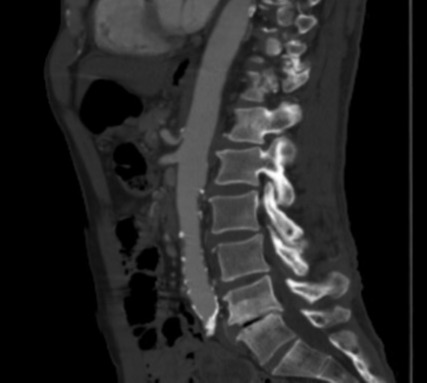Back
Poster Session E - Tuesday Afternoon
E0711 - Chronic Abdominal Pain Mystery: Median Arcuate Ligament Syndrome
Tuesday, October 25, 2022
3:00 PM – 5:00 PM ET
Location: Crown Ballroom

Michael Tran, MD
University of South Alabama
Mobile, AL
Presenting Author(s)
Michael Tran, MD, Anas Khouri, MD, Abrahim Hanjar, MD, Phillip Henderson, DO
University of South Alabama, Mobile, AL
Introduction: Median arcuate ligament syndrome (MALS), also known as celiac artery compression syndrome, is a rare anatomic disorder (2:100,000) that is more prevalent in women (4:1 ratio) with thin body habitus. Average age of presentation is 30 to 50 years old. It is characterized by weight loss, postprandial abdominal pain, nausea, and vomiting. We present a case of MALS in a 68-year-old male with nonspecific GI symptoms.
Case Description/Methods: 68-year-old male with history of alcohol use and ex-lap presents with postprandial dull abdominal pain left to the umbilicus and radiates to the back. Accompanied by early satiety, and 10-20 lbs of unintentional weight loss over one-year. He had normal bowel movements with no melena or hematochezia. He took opioids, pantoprazole, and over the counter pain medications with some relief. He was evaluated with esophagogastroduodenoscopy, colonoscopy, abdominal ultrasound and a computed tomography (CT) of the abdomen and pelvis with contrast. These investigations did not yield any significant findings. CTA abdominal aorta with runoff was ordered due to concern of chronic mesenteric ischemia. It showed focal stenosis of the origin of the celiac axis with minimal post stenotic dilation. Patient was referred to vascular surgery who performed laparoscopic robot assisted median arcuate ligament release. Surgery was converted to open supra-umbilical laparotomy due to difficult visualization of the celiac artery origin. A thick band compressing the anterior surface of the celiac artery was freed. Post-surgery, patient had relief of his abdominal pain and has been recovering well.
Discussion: Median arcuate ligament syndrome is a diagnosis of exclusion. It usually presents with nonspecific symptoms, and many patients can be asymptomatic and be found incidentally. It is believed that MALS causes inflammation and compression of the celiac plexus causing the symptoms. MALS is difficult to diagnose, especially in the absence of a standardized algorithm to aid in diagnosis and treatment. Our case was unique as our patient did not match with the typical demographics of patients with MALS. He was a male, in his 60’s, with average weight. Clinicians should keep a high suspicion of MALS with patients who have postprandial abdominal pain and weight loss with negative initial workup. Diagnosis could be made by ultrasound, CT imaging, or CTA and MRA. Definitive management involves surgery with 85% of patients experiencing postop pain relief in one study.

Disclosures:
Michael Tran, MD, Anas Khouri, MD, Abrahim Hanjar, MD, Phillip Henderson, DO. E0711 - Chronic Abdominal Pain Mystery: Median Arcuate Ligament Syndrome, ACG 2022 Annual Scientific Meeting Abstracts. Charlotte, NC: American College of Gastroenterology.
University of South Alabama, Mobile, AL
Introduction: Median arcuate ligament syndrome (MALS), also known as celiac artery compression syndrome, is a rare anatomic disorder (2:100,000) that is more prevalent in women (4:1 ratio) with thin body habitus. Average age of presentation is 30 to 50 years old. It is characterized by weight loss, postprandial abdominal pain, nausea, and vomiting. We present a case of MALS in a 68-year-old male with nonspecific GI symptoms.
Case Description/Methods: 68-year-old male with history of alcohol use and ex-lap presents with postprandial dull abdominal pain left to the umbilicus and radiates to the back. Accompanied by early satiety, and 10-20 lbs of unintentional weight loss over one-year. He had normal bowel movements with no melena or hematochezia. He took opioids, pantoprazole, and over the counter pain medications with some relief. He was evaluated with esophagogastroduodenoscopy, colonoscopy, abdominal ultrasound and a computed tomography (CT) of the abdomen and pelvis with contrast. These investigations did not yield any significant findings. CTA abdominal aorta with runoff was ordered due to concern of chronic mesenteric ischemia. It showed focal stenosis of the origin of the celiac axis with minimal post stenotic dilation. Patient was referred to vascular surgery who performed laparoscopic robot assisted median arcuate ligament release. Surgery was converted to open supra-umbilical laparotomy due to difficult visualization of the celiac artery origin. A thick band compressing the anterior surface of the celiac artery was freed. Post-surgery, patient had relief of his abdominal pain and has been recovering well.
Discussion: Median arcuate ligament syndrome is a diagnosis of exclusion. It usually presents with nonspecific symptoms, and many patients can be asymptomatic and be found incidentally. It is believed that MALS causes inflammation and compression of the celiac plexus causing the symptoms. MALS is difficult to diagnose, especially in the absence of a standardized algorithm to aid in diagnosis and treatment. Our case was unique as our patient did not match with the typical demographics of patients with MALS. He was a male, in his 60’s, with average weight. Clinicians should keep a high suspicion of MALS with patients who have postprandial abdominal pain and weight loss with negative initial workup. Diagnosis could be made by ultrasound, CT imaging, or CTA and MRA. Definitive management involves surgery with 85% of patients experiencing postop pain relief in one study.

Figure: CTA Image
Disclosures:
Michael Tran indicated no relevant financial relationships.
Anas Khouri indicated no relevant financial relationships.
Abrahim Hanjar indicated no relevant financial relationships.
Phillip Henderson indicated no relevant financial relationships.
Michael Tran, MD, Anas Khouri, MD, Abrahim Hanjar, MD, Phillip Henderson, DO. E0711 - Chronic Abdominal Pain Mystery: Median Arcuate Ligament Syndrome, ACG 2022 Annual Scientific Meeting Abstracts. Charlotte, NC: American College of Gastroenterology.
